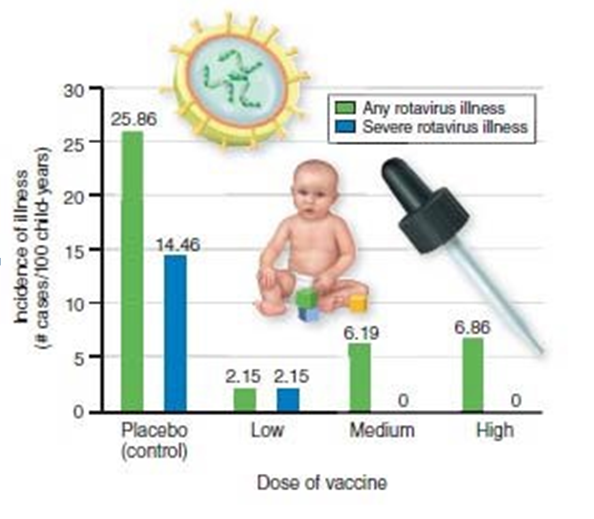In the graph, interpret the data that are shown regarding the response of a large number of infants to vaccination from dangerous rotavirus infection. Which of the hypotheses is NOT supported by these data results?

This figure shows graphed medical research results from a study on a new vaccine. The research was done in an effort to determine if a new vaccine would be effective in preventing potentially dangerous rotavirus infections in infants. Green data bars represent occurrence of infant cases that had normal rotavirus strains that aren't critically dangerous. Blue data bars represent occurrence of infant cases that had more dangerous rotavirus strains that can hospitalize or lead to fatality of infants.
A. The low dose of the vaccine reduces incidence of illness from any rotavirus in general, and also severe rotavirus.
B. The new vaccine is ineffective in protecting infants from any rotavirus infection.
C. Hypotheses about the vaccine doses can't be evaluated because the placebo group is biased, with high incidence of illness in those infants.
D. Medium and high doses of the vaccine are more effective at reducing severe rotavirus illnesses than reducing any rotavirus.
E. The high dose of the new vaccine does not offer any stronger protection from any rotavirus infection than the medium dose.
B. The new vaccine is ineffective in protecting infants from any rotavirus infection.
You might also like to view...
Cassava roots release the toxin hydrogen cyanide when their cells are damaged
A. true B. false
In meiotic non-disjunction, meiotic products can be n+1, n-1, or n depending on when non-disjunction occurs
For the n+1 product can you tell if non-disjunction occurred in meiosis I or II if the non-disjunction happened to an autosome? What about a sex chromosome? A. No; yes B. No; no C. Yes; yes D. Yes; no
What is the main reason for why there has not been an increase in the production of new nuclear power plants?
a. the high cost of building b. the high cost to produce electricity c. lack of nuclear fuels d. safety concerns e. high greenhouse gas effects
How many bones are in the human body?
A) 203 B) 206 C) 300 D) 308